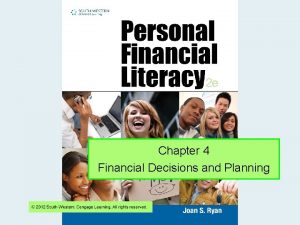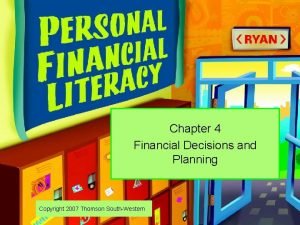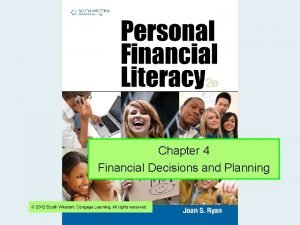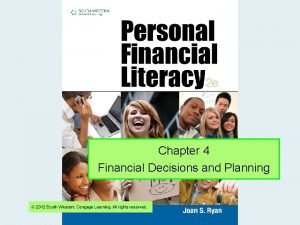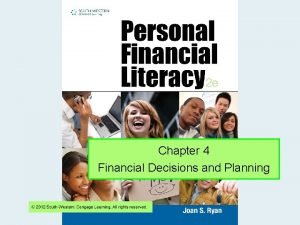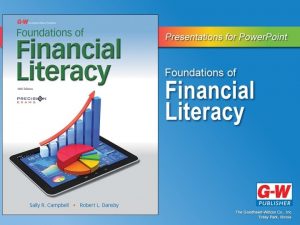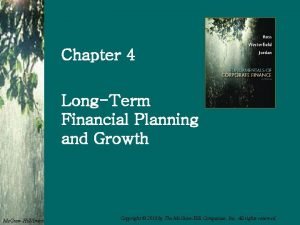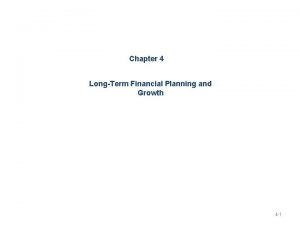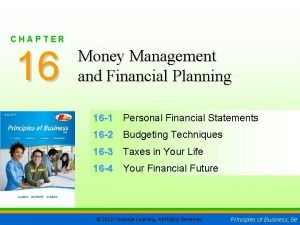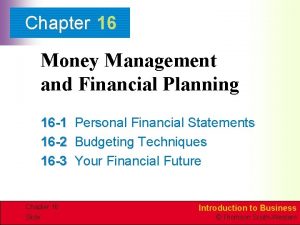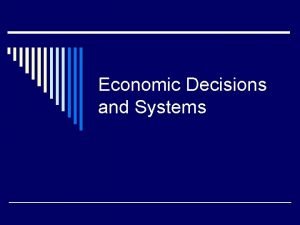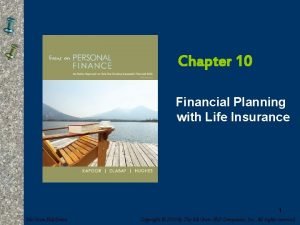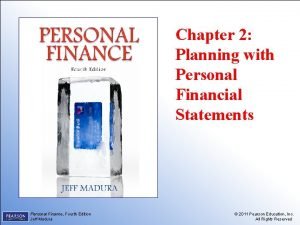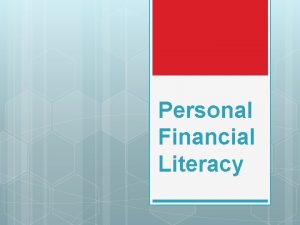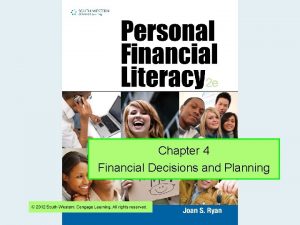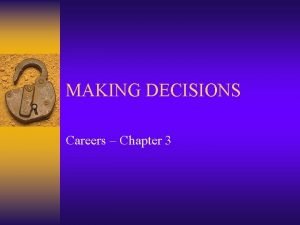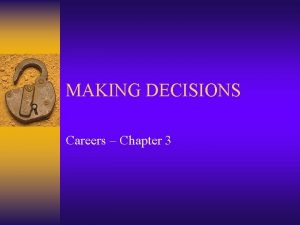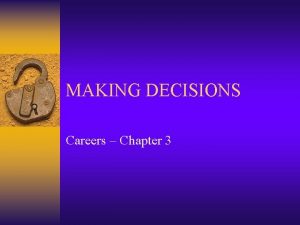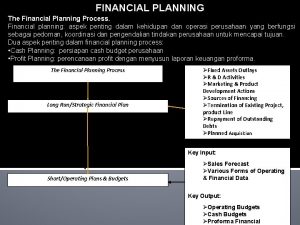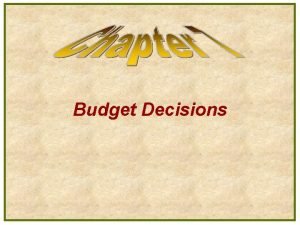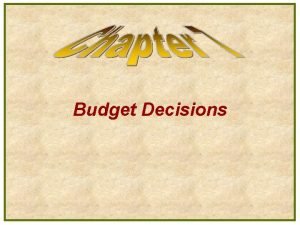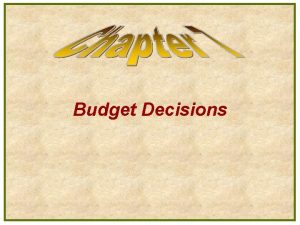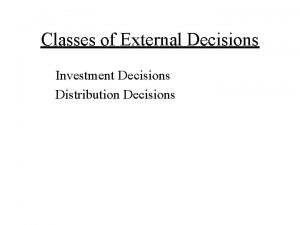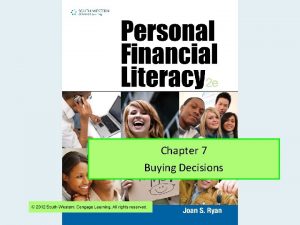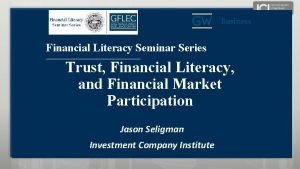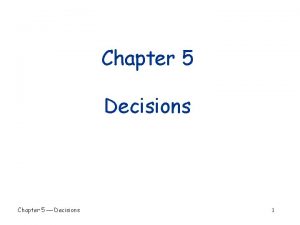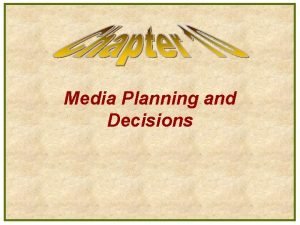Chapter 4 Financial Decisions and Planning Financial Literacy























- Slides: 23

Chapter 4 Financial Decisions and Planning

Financial Literacy • Chapter 4 Objectives – Describe needs and wants – Apply a decision making process to make personal financial choices – Understand terms on personal cash flow statements and net worth statements – Prepare a personal budget, planning for projected income and expenses – Explain and draft a financial plan Slide 2

What Are Needs and Wants? • Needs are things you must have. o Examples: food, clothing, shelter • Wants are things people desire. o Examples: new cars, vacations, luxury items • Financial resources are used to acquire goods and services. 4 -1 Resources and Choices Slide 3

Resources Limit Choices • People’s wants and needs are unlimited • Financial resources are limited • With limitations comes choice Slide 4

How Are Income and Wealth Measured? See page 120 • Personal cash flow statement lists cash inflows and outflows. o Inflows = income o Outflows = expenses • Personal net worth statement shows a person’s net worth based on assets and liabilities. o Assets = money or items of value o Liabilities = debts 4 -1 Resources and Choices Slide 5

How Is Wealth Measured? See page 120 PERSONAL NET WORTH STATEMENT Assets Cash and checking account Liabilities $ 452. 56 Car loan $1, 100. 00 Savings account 500. 00 Credit card debt 200. 98 Savings bond 300. 00 Total liabilities $1, 300. 98 Baseball card collection 100. 00 Computer, i. Pod, games 300. 00 Car, current value Total assets 3, 000. 00 Net Worth $4, 652. 56 Assets minus liabilities Total liabilities and net worth 3, 351. 58 $4, 652. 56 Net Worth 4 -1 Resources and Choices Slide 6

Know these terms well: From the Value of Assets Net Worth Statement Ø Appreciating: Assets Ø Assets: Money and that are growing in value, items of value that you ex. Land, house, savings own bonds Ø Liabilities: Debts that Ø Depreciating: Assets you owe that are decreasing in Ø Net Worth: difference value, ex. Cars and between your assets and electronics your liabilities Slide 7

Financial Strategies • Consider your future – how will this choice affect your future? • If you have doubt, don’t buy it - wait • Avoid buyer’s remorse: (emotional or impulse buys) • Learn from other’s mistakes Slide 8

What Is the Purpose of Budgeting? • A budget is a spending and saving plan. • It is based on estimated income and expenses. • Use spreadsheet software to prepare a budget. 4 -2 Basics of Budgeting Slide 9

How Do You Prepare a Budget? • Step 1: Estimate income • Step 2: Plan for savings (10% to start) • Step 3: Estimate expenses o Variable expenses- ex. Gas and electric bill o Fixed expenses – ex. Rent, car payment o Charitable giving • Step 4: Balance the budget: Budget Equation Savings + Expenses = Income 4 -2 Basics of Budgeting Slide 10

Personal Budget Income Work (part-time) Allowance for household chores Lunch money allowance Savings account interest Total income Weekly Monthly Yearly $30. 00 15. 00. 50 $55. 50 $120. 00 40. 00 60. 00 2. 00 $222. 00 $1, 440. 00 480. 00 720. 00 24. 00 $2, 664. 00 $ 5. 50 $ 22. 00 $ 264. 00 Gifts Clothes and shoes Loan payment to parents Lunches Entertainment/miscellaneous Total expenses $ 5. 00 15. 00 10. 00 $50. 00 $ 20. 00 60. 00 40. 00 $200. 00 $ 240. 00 720. 00 480. 00 $2, 400. 00 Total savings and expenses $55. 50 $222. 00 $2, 664. 00 Savings Deposit to savings account Expenses 4 -2 Basics of Budgeting Slide 11

Preparing a Budget Analysis • Not everything will go as planned • Variances – Difference between planned amounts and actual amounts • Favorable and Unfavorable (F or U) Slide 12

Record Keeping • Manual – Pen and paper – Keep it somewhere safe • Electronic – Using software such as Quicken or Quickbooks – Microsoft Excel – Google Docs Slide 13

Q&A: Answer these Questions in space below: page 123: #13, #14, #16 • Then go to Activity 1 in back of packet. Slide 14

Financial Literacy …continuing Chapter 4 • Current Objectives: – Identify the purpose of a personal budget – Prepare a personal budget – Learn how to analyze and prepare for variances in a budget – Learn importance of Financial Planning Slide 15

What Is Financial Planning? • Financial planning is a process of looking at your current financial situation and thinking about your future. • A financial plan has personal and financial goals along with steps and a timeline. • Review and update your financial plan periodically. • Helps you insure that your “net worth” increases over time 4 -3 Personal Financial Planning Slide 16

Financial Planning Steps to Success • Step 1: Gather financial information • Step 2: Analyze information • Step 3: Set goals o Personal and financial • Step 4: Develop a timeline and benchmarks • Step 5: Implement and evaluate the plan 4 -3 Personal Financial Planning Slide 17

Financial Plan (One Goal) FINANCIAL PLAN Net worth on April 1, 20 --: $525. 56 Personal Goal Financial Goal Benchmarks Timeline Live in my own house in the country. Buy a house in the country. 1. Save money for a down payment ($12, 000) 5 years • Set aside $200 per month Once per month • Open a separate account for money saved April 8 (next week) • Talk to a mortgage broker to get prepared Make an appointment for April 15 2. Get a job that provides enough income to make monthly payments 4 -3 Personal Financial Planning 2 years Slide 18

Success Skills for Life: Tips for Dealing With Conflict… • Stop and take a ten-second time out. o Ask yourself “what is happening here? ” o Listen rather than talk. • Suggest that you continue your talk later. • Focus on the problem, not the person. • Be willing to compromise when appropriate. 4 -2 Basics of Budgeting Slide 19

Focus On. . . Philanthropy • Philanthropy is a form of charitable giving. • It is the primary source of funding for the fine arts, performing arts, and most religious and humanitarian causes. • It is good to add some sort of charitable giving to your budget, through a church, a non-profit cause, or other reputable organization 4 -2 Basics of Budgeting Slide 20

Activity 1 1. What do things really cost? – Find a cell phone plan – monthly cost? • Pick a phone, add to cart, then go through individual plans. • Write in your choice and monthly cost: • _________________ – Find TV and Internet Service – monthly cost? • Could be a bundle or separate. • Write in your choice and monthly cost: • __________________ 2. Ch. 4 Key Terms List Slide 21

Activity 2 – What is your monthly car payment? 1. Find your car on any website and write price: Car: _______Total price: _______ • Then, using autos. yahoo. com – Go to the Finance tab – Select the Monthly Payment calculator • Info needed: – Your car sales price – You will put $1500 down payment – Interest: Choose national average • Monthly car payment: _______ 2. Finish Ch. 4 Key Terms List Slide 22

Activity 3 1. What is your estimated annual/monthly income for your future career? (see green Career WS ) Annual Income: _______ Monthly Income: _______ 2. Start a new Spreadsheet in Excel OR use my Sample Budget template on my website and SAVE AS: “Your Name, Personal Monthly Budget” • Set up the Rows as on My Sample Budget on my website 3. In your Excel Personal Budget spreadsheet Add in your researched decisions: Ø Monthly income Ø Monthly car payment Ø Monthly cell phone payment Ø Monthly TV/Internet payment. 4. Save as “Personal Budget” in the “Fin Lit” folder you created on your server Slide 23
 Meaning of poster making
Meaning of poster making Chapter 4 financial decisions and planning
Chapter 4 financial decisions and planning Chapter 4 financial decisions and planning
Chapter 4 financial decisions and planning Chapter 4 financial decisions and planning
Chapter 4 financial decisions and planning Chapter 4 financial decisions and planning
Chapter 4 financial decisions and planning Chapter 4 financial decisions and planning
Chapter 4 financial decisions and planning Screening decisions and preference decisions
Screening decisions and preference decisions Venn diagram of media information and technology literacy
Venn diagram of media information and technology literacy Medium in mil
Medium in mil Who are people in media
Who are people in media Cyber literacy for the digital age
Cyber literacy for the digital age Financial literacy basics chapter 1 answers
Financial literacy basics chapter 1 answers Long term financial planning and growth chapter 4
Long term financial planning and growth chapter 4 Internal growth rate formula
Internal growth rate formula Chapter 16 money management and financial planning
Chapter 16 money management and financial planning Chapter 16 money management and financial planning
Chapter 16 money management and financial planning Financial literacy and education commission
Financial literacy and education commission Financial literacy and stock market participation
Financial literacy and stock market participation Chapter 10 personal loans and purchasing decisions
Chapter 10 personal loans and purchasing decisions Chapter 1 economic decisions and systems answer key
Chapter 1 economic decisions and systems answer key Chapter 10 financial planning with life insurance
Chapter 10 financial planning with life insurance Chapter 2 personal financial planning answers
Chapter 2 personal financial planning answers Bhartiya model of financial literacy
Bhartiya model of financial literacy Tariff calculation formula
Tariff calculation formula

